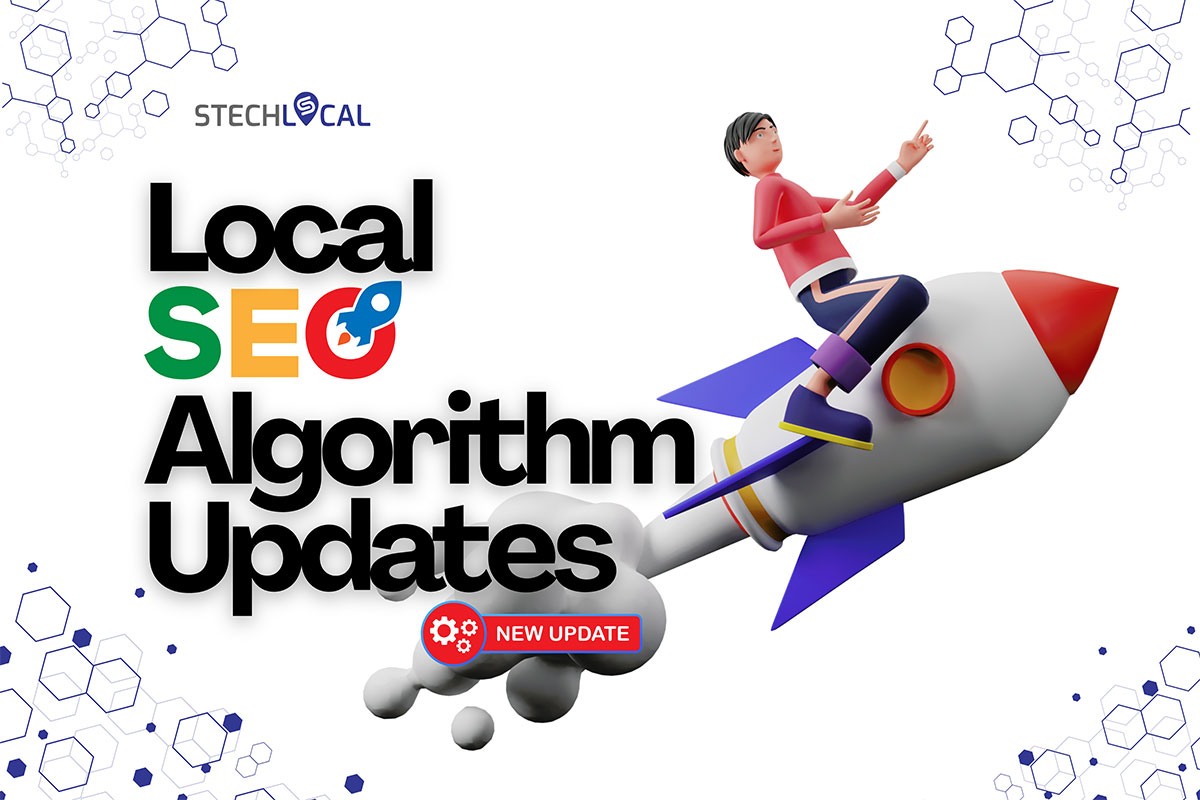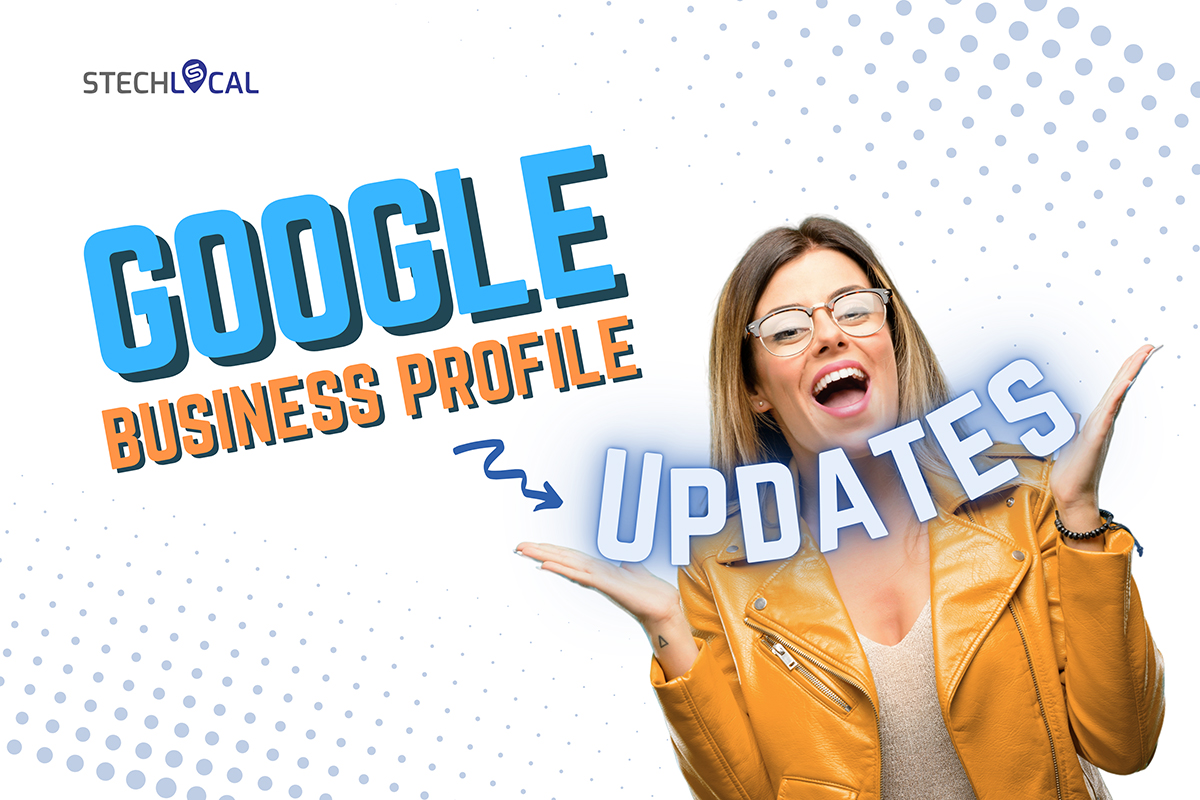What Are AI Overviews for Local Search in 2025
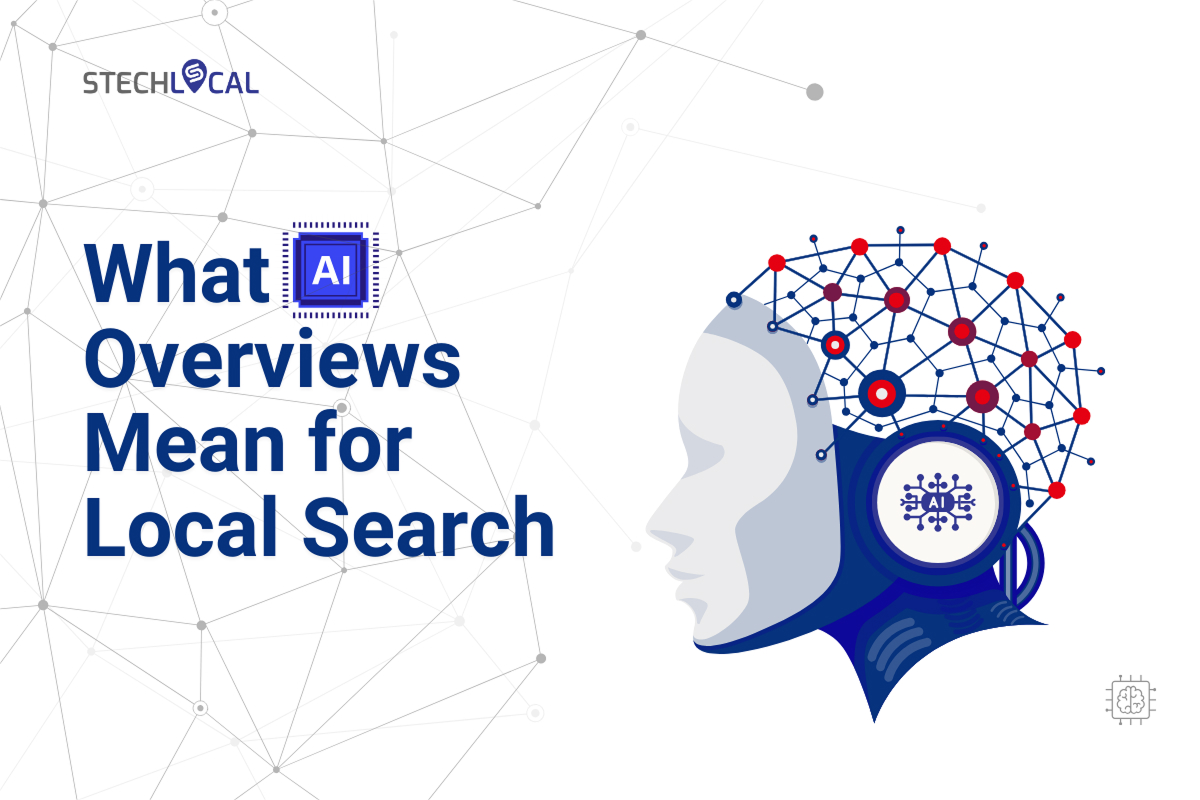
If you’ve noticed fewer clicks from Google lately, you’re not imagining it. The search landscape is undergoing one of the most significant transformations in over a decade—and it’s powered by artificial intelligence.
With the rollout of AI Overviews for local search, users now see AI-generated summaries at the top of search results. This shift is already reshaping local search behavior across the U.S.—with adoption accelerating fast.
This comprehensive guide highlights what AI Overviews by Google actually are, how they impact local business visibility, why AI Overviews often replace standard results, and how to optimize your Google presence to stay competitive in a world where AI in local SEO is no longer the future—it’s the present.
What Are AI Overviews for Local Search?
AI Overviews, previously known as Google’s Search Generative Experience (SGE), are AI-powered summaries that appear at the top of Google’s search results.
According to a 2025 Semrush study, the trigger rate for AI Overviews rose from 6.5% in January to 13.1% by March, underscoring how quickly this feature is expanding across search queries.
Unlike traditional blue links, these summaries are auto-generated using advanced language models trained to understand and synthesize data from multiple sources across the web.
How AI Overviews Generate Responses
Google uses generative AI to scan and process content from many trusted, high-authority sources, including websites, product listings, review platforms, and public knowledge graphs.
The sources are analyzed for relevance, topical authority, and alignment with the user’s intent. The AI then composes a summarized answer in natural language, often including citations that link to the source material. These AI summaries in Google aim to deliver a more complete response than traditional snippets.
According to Google and reporting by the Financial Times, the adoption of AI Overviews has driven more than a 10% increase in search volume across key markets like the U.S. and India.
This surge reflects not only growing user trust in AI-generated summaries, but also a major shift in how people interact with Google Search—moving from clicking links to consuming AI-curated answers.
AI Overviews vs. Featured Snippets: What’s the Difference?
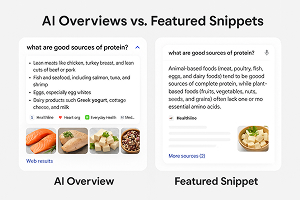
It’s important not to confuse AI Overviews with Featured Snippets—although both appear above organic results.
- Featured Snippets pull a single excerpt from one web page to answer a direct query.
- AI Overviews, by contrast, use multiple sources to generate a more comprehensive, AI-written summary.
- Featured Snippets are static and manually optimized; AI Overviews are dynamic and adapt based on context and query complexity.
Why Source Credibility and Structure Matter
The inclusion of your business, article, or page in an AI Overview depends heavily on the quality of your content structure and the trustworthiness of your site.
Google’s AI prioritizes content that follows best practices for E-E-A-T (Experience, Expertise, Authoritativeness, and Trustworthiness).
Structured content with schema markup, proper subheadings, and clearly sourced claims increases your chances of being cited in these summaries.
AI Overviews Pull from Multiple Sources—Not Just Websites
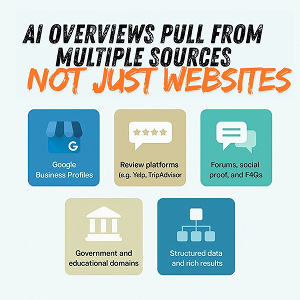
One of the most critical shifts with this feature is that Google AI snippets aren’t limited to traditional web pages. AI Overviews aggregate information from:
- Google Business Profiles
- Review platforms
- Forums, social proof, and FAQs
- Government and educational domains
- Structured data and rich results
This means your visibility in AI Overviews isn’t solely dependent on your website—it extends to how your business appears across the broader ecosystem of local content and platforms.
Why Local Businesses Need to Care
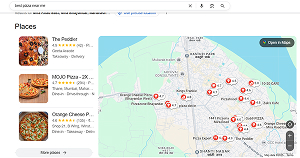
For local businesses, AI Overviews are not just another Google feature—they’re a disruptive force that’s reshaping how potential customers find, evaluate, and choose local services.
If you’re still relying solely on map pack rankings or basic SEO, this new search experience could sideline your business unless you adapt quickly.
AI Overviews Are Now Answering Local Queries
Searches like “best pizza near me,” “top-rated law firms in Houston,” or “affordable dentists in Atlanta” are increasingly triggering AI-generated summaries instead of (or in addition to) the familiar local 3-pack.
These summaries don’t just display a list; they synthesize data from multiple sources and offer direct, conversational answers. And they often pull business names, ratings, services, and location info into the overview—before a user clicks.
Reduced Click-Through Rates to Traditional Listings
This shift to AI Overviews in Google is driving a measurable drop in organic engagement.
According to recent data reported by the Pew Research Center, click-through rates fall to just 8% when AI Overviews appear, compared to 15% when they don’t—highlighting how users increasingly stop at the AI-generated summary without exploring traditional listings.
The “zero-click” behavior makes it harder for local businesses to stand out unless they are directly cited or referenced within the AI Overview.
AI Overviews aren’t just affecting rankings—they’re eliminating them. According to The Times, this new AI-powered layer has been dubbed a “search killer” that could permanently reduce traffic to traditional websites. The shift to zero-click results means if your business isn’t featured in the AI summary, you’re effectively invisible.
“If your business isn’t included in the AI-generated response, you’re invisible—even if you rank well.” – Akmal Faizan, Founder, Stech Local
AI Overviews Prioritize Trust Signals and Public Reputation
Unlike traditional local SEO, which relies heavily on proximity and basic optimization of your Google Business Profile, AI Overviews pull data from:
- Customer reviews and reputation scores
- Consistency across citations (NAP)
- Service-specific content on your website
- Topical authority and real-world trust signals
- GBP Q&A and third-party platform visibility
A New Standard for Visibility in Local Search
In the age of AI in local SEO, visibility is no longer about proximity alone—it’s about authority, clarity, and trust. Businesses with optimized GBP listings, AI-friendly content, and consistent customer feedback will dominate this new layer of search.
How Google Chooses Local Sources for AI Overviews
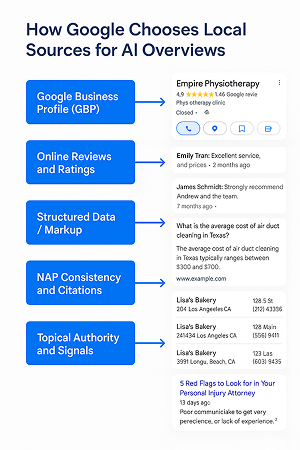
1. Google Business Profile (GBP) Signals
Your Google Business Profile is pivotal in AI Overviews for local queries. Google uses:
- Business categories, services, and attributes
- Review count, quality, and recency
- Consistency of business name, address, phone number (NAP)
- Photos and image alt text
- Q&A and business descriptions
2. Online Reviews and Ratings
Customer reviews across Google and third-party sites act as both trust signals and sentiment data. If your reviews mention specific services (e.g., “emergency plumbing in Chicago”), those keywords can help trigger your business as a relevant entity in AI Overviews. Review management tool can help you in the process. Google’s AI evaluates:
- Star ratings and number of reviews
- Frequency of recent reviews
- Sentiment (positive/negative)
- Review content that matches the search query
- Owner response behavior and engagement
3. Structured Data and Schema Markup
Pages that use LocalBusiness, Service, Review, and FAQ schema give AI models clearer context on what your business does and who it serves. This structured markup helps Google validate your authority and surface your content more confidently in AI responses.
Key schema types for local businesses:
- LocalBusiness
- Product (for service-specific offerings)
- FAQPage
- Review
- Service
4. NAP Consistency and Citations
Google’s AI models assess consistency across directories and listings. If your business info is outdated or conflicting on major platforms (e.g., Yelp, Bing, Apple Maps, Facebook), your trustworthiness as a source declines.
5. Topical Authority and Third-Party Signals
Websites that demonstrate expertise in their niche (e.g., HVAC, personal injury law, dental care) are more likely to be cited in AI Overviews. The more your business is referenced and discussed online with accuracy and authority, the more likely Google is to trust it as part of an AI-generated answer.
Signals include:
- In-depth, service-specific blog content
- Local press mentions
- High-quality backlinks
- Positive brand mentions on forums, review sites, and social platforms
Types of Local Queries Triggering AI Overviews
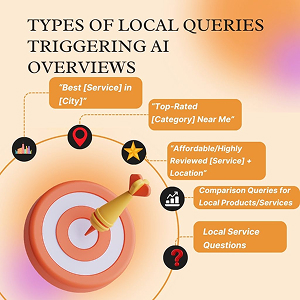
Google’s AI Overviews are increasingly triggered by local intent queries, especially those involving comparisons, recommendations, or reviews.
1. “Best [Service] in [City]”
Example: Best family lawyers in Dallas
These are high-intent, competitive queries that traditionally showed the Local Pack. Now, AI Overviews are taking the lead by listing multiple providers with short descriptions pulled from reviews, Google Business Profiles, and third-party sites.
Optimization Tip: Ensure your GBP category and reviews align with the query language. Use service-related keywords naturally in your content and GBP description.
2. “Top-Rated [Category] Near Me”
Example: Top-rated HVAC companies near me
AI Overviews interpret “top-rated” using star ratings, review volume, and overall sentiment across platforms. Businesses with consistently high ratings and recent reviews are more likely to be included.
Optimization Tip: Focus on steady review generation and respond to every review, especially recent ones.
3. “Affordable/Highly Reviewed [Service] + Location”
Example: Affordable wedding photographers in Nashville
AI Overviews parse “affordable” and “highly reviewed” using price ranges (if available) and customer feedback. Businesses with value-focused language in reviews or on their website may be prioritized.
Optimization Tip: Include pricing info in your GBP (if eligible), and encourage happy customers to mention value and pricing in their reviews.
4. Comparison Queries for Local Products/Services
Example: Chiropractor vs Physical Therapist in San Diego
AI Overviews generate educational content plus provider recommendations, often referencing local practices, services, or clinics.
Optimization Tip: Publish content that educates users on your services vs alternatives. Use schema markup to clarify services offered.
5. Local Service Questions
Example: Do plumbers in Miami offer emergency service?
AI Overviews pull directly from GBP services, website FAQs, and review mentions to answer these. Businesses that clearly state service availability and hours are favored.
Optimization Tip: Add detailed services to your GBP, including emergency offerings. Use FAQs and Q&A to reinforce availability and specializations.
How To Optimize for AI Overviews as a Local Business
To appear in these AI-generated summaries, you need to optimize across multiple dimensions—content, technical SEO, trust signals, and external citations.
1. Fully Optimize Your Google Business Profile (GBP)
Your GBP is foundational. Google’s AI pulls heavily from it when generating summaries for local queries.
Must-do actions:
- Fill out all sections: business description, categories, services, hours, and images
- Add high-quality photos with descriptive alt text
- Regularly update posts and promotions
- Monitor and answer Q&As from the public
- Use keywords naturally in your business description and service list
2. Generate and Respond to Reviews Consistently
Reviews are a key data source for Google’s AI summaries. They serve both as sentiment indicators and user-generated content that reinforces relevance.
Best practices:
- Use SMS/email campaigns to request reviews post-service
- Encourage customers to mention specific services and experiences
- Respond promptly with a professional, personalized tone
- Address negative feedback to build trust and show credibility
- Avoid fake or incentivized reviews—these can hurt your visibility
3. Use Structured Data and Schema Markup
Schema helps Google (and its AI models) interpret your content accurately. It also increases the chances of your business info being included in AI Overviews and rich results.
Recommended schema types:
- LocalBusiness
- Service
- Review
- FAQPage
- Organization
- AggregateRating
4. Publish Helpful, Hyperlocal Content on Your Website
Local business websites that consistently answer common service questions, provide how-to guides, and explain offerings are more likely to be referenced.
Content ideas:
- “How to choose the right [service] in [city]”
- “What to expect from a first visit to our [business type]”
- FAQ-style blogs answering location-specific questions
- Comparison content (e.g., urgent care vs. ER in [city])
- Showcase customer testimonials in blog form
5. Build High-Quality Citations and Backlinks
Google’s AI considers off-site trust signals to validate and supplement what’s on your website and GBP.
Focus on:
- Consistent NAP (name, address, phone) across all major directories
- Citations from industry-specific and location-based sites
- Press mentions, sponsorships, and partnerships that get you listed on authoritative domains
- Earning links from trusted blogs, chambers of commerce, and local publications
6. Maintain Accuracy and Trust Across Platforms
Ensure that your business name, services, contact info, and branding are uniform across all digital touchpoints, including:
- Yelp
- Bing Places
- Apple Maps
- Local directories
- Review aggregators
7. Align with E-E-A-T Principles
Google’s AI uses Experience, Expertise, Authoritativeness, and Trustworthiness to decide what content to feature.
To improve your E-E-A-T:
- Display professional credentials and awards
- Include staff bios, certifications, and real-world experience
- Publish case studies or success stories
- Collect and feature verified reviews and testimonials
- Maintain a secure, fast, and mobile-optimized website
Role of Reviews, Photos, and Q&A in AI-Generated Summaries
Reviews, photos, and Q&A sections are now critical components of your visibility in AI-generated summaries.
1. Reviews: The Voice of Social Proof and Sentiment
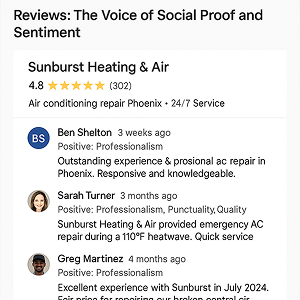
Reviews are one of the most powerful data sources used in Google AI snippets. The language, volume, and tone of your reviews help AI models determine:
- What services you offer
- What customers value about you
- Whether your business is reputable and consistent
- How your offerings compare to competitors
Key Optimization Tips:
- Encourage keyword-rich reviews: Ask customers to mention the service and location (“emergency AC repair in Phoenix”).
- Respond with authority: Use owner responses to reinforce your expertise, availability, and professionalism.
- Keep it fresh: Recency matters. Frequent reviews indicate you’re active and trustworthy.
- Avoid spammy tactics: Fake or purchased reviews can hurt your ranking and reputation.
2. Photos: Visual Signals for Trust and Relevance
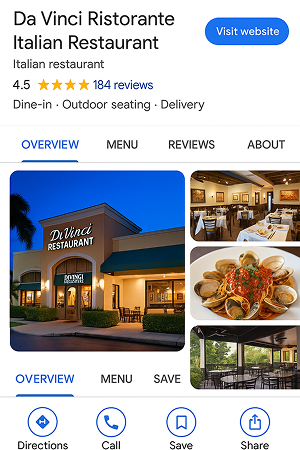
Images on your GBP, especially those uploaded by customers, are increasingly referenced by Google’s AI systems. Google’s AI uses image metadata and visual recognition to match photos to relevant search queries and intent. Photos provide visual evidence of:
- Location, cleanliness, and ambiance
- Service offerings (e.g., dishes in a restaurant, dental equipment, team shots)
- Brand professionalism
- Consistency with user expectations
Best Practices:
- Upload high-resolution, original images regularly
- Include images of your storefront, services in action, staff, and satisfied customers
- Use descriptive file names and alt text for every photo
- Encourage customers to share photos in their reviews
3. Q&A: A Hidden Goldmine for AI Optimization
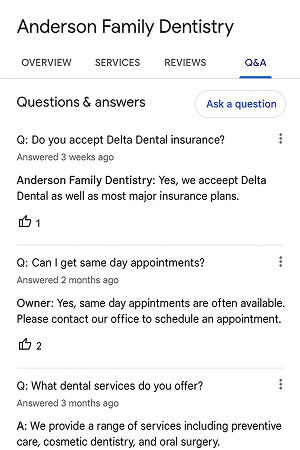
The Q&A section of your Google Business Profile is often overlooked—but it’s a direct source of FAQ-style content that AI can parse and summarize.
How To Optimize:
- Seed your own questions and answer them as the business owner
- Focus on common queries related to services, availability, insurance, pricing, and unique value props
- Use natural language and location-specific keywords in both questions and answers
- Monitor and update outdated or unclear answers from the public
AI Overviews vs Traditional Local Pack: What’s Changing?
Google’s AI Overviews and the Local 3-Pack now coexist—but they operate on fundamentally different rules. Understanding how they differ is essential for local businesses looking to protect (and grow) visibility in an evolving search landscape.
Below is a direct comparison of both systems:
| Feature | AI Overview | Local 3-Pack |
|---|---|---|
| Click-Through Rate | Lower – users get instant answers without clicking | Higher – users explore individual business listings |
| Ranking Factors | Content quality, topical authority, reviews, E-E-A-T | Proximity, NAP consistency, GBP optimization, reviews |
| Control | Indirect – based on content trust and cross-platform signals | Direct – GBP data and traditional local SEO |
| Source Type | Multiple sources: websites, reviews, GBP, citations | Primary source: Google Business Profile |
| Query Intent | Informational, comparative, decision-aid | Navigational, transactional |
| Experience Type | AI-written answer with links or citations | Map-based list with clickable profiles and CTAs |
| Top Performer | Businesses with a strong digital reputation and entity authority | Businesses nearest to the user with optimized GBP |
Case Studies:
Case Study 1: Personal Injury Law Firm Gains Visibility in AI Overview for “Top Car Accident Lawyers in Austin”
Industry: Legal / Personal Injury Law
Query Triggered: “Top car accident lawyers in Austin”
A small but experienced personal injury firm noticed a decline in traffic from traditional map pack listings but saw a growing number of consultations from users who said they found them “in the AI summary at the top of Google.”
What They Did:
- Fully updated their Google Business Profile with precise services like “rideshare accident claims” and “free case reviews”
- Earned 20+ 5-star reviews within two months, many of which used search-relevant terms such as “car accident,” “settlement,” and “Austin”
- Implemented schema (LegalService, Review, FAQPage) across core service pages
- Published helpful blog content answering questions like “How long does a car accident claim take?”
- Used review replies and Q&A to reinforce legal expertise and response professionalism
Results:
- Appeared in the AI Overview summary for target queries with star ratings and review snippets
- Experienced a 19% increase in high-quality consultation requests over six weeks
- Achieved a stronger presence in branded and voice search traffic
- Gained trust from Google’s AI via consistent listings on legal directories and review platforms
Case Study 2: Boutique Hotel Ranks in AI Overview for “Best Romantic Hotels in Brooklyn
Industry: Hospitality / Boutique Hotel
Query Triggered: “Best romantic hotels in Brooklyn”
A luxury boutique hotel in a popular tourist town began receiving more direct bookings and brand searches after guests discovered the property through an AI-generated summary in Google Search.
Optimization Strategy:
- Enhanced their GBP with rich attributes like “romantic,” “fireplace suites,” and “couples’ getaway”
- Collected guest reviews that included experiences like anniversaries, honeymoons, and romantic ambiance
- Published blog content focused on seasonal guides and couple-centric experiences in the area
- Used structured data (Hotel, Offer, AggregateRating) across the site
- Secured backlinks from lifestyle blogs and local experience partners to strengthen authority
Results:
- The business was featured in AI Overviews for high-converting local queries
- Organic bookings rose 23% within one month
- Voice search visibility improved for “romantic hotel near Brooklyn” type queries
- Website engagement and direct traffic from branded queries increased significantly
Read Also: Local SEO Algorithm Update
Summary
What Are AI Overviews?
AI Overviews, previously known as Google’s Search Generative Experience (SGE), are AI-powered summaries that appear at the top of Google’s search results.
How AI Overviews Generate Responses
Google uses generative AI to synthesize content from trusted sources like websites, reviews, listings, and knowledge graphs.
AI Overviews vs. Featured Snippets: What’s the Difference?
Unlike static Featured Snippets that quote a single source, AI Overviews generate dynamic, multi-source summaries tailored to query context.
Why Source Credibility and Structure Matter
Google’s AI favors well-structured, trustworthy content that follows E-E-A-T principles and uses schema markup to improve your chances of inclusion in AI Overviews.
AI Overviews Pull from Multiple Sources—Not Just Websites
A key shift with AI Overviews is that Google pulls data from across the web—including GBP, reviews, forums, and structured data—making your visibility dependent on your entire digital footprint, not just your website.
Why Local Businesses Need to Care
- AI Overviews Are Now Answering Local Queries
- Reduced Click-Through Rates to Traditional Listings
- AI Overviews Prioritize Trust Signals and Public Reputation
- A New Standard for Visibility in Local Search
How Google Chooses Local Sources for AI Overviews
- Google Business Profile (GBP) Signals
- Online Reviews and Ratings
- Structured Data and Schema Markup
- NAP Consistency and Citations
- Topical Authority and Third-Party Signals
Types of Local Queries Triggering AI Overviews
- “Best [Service] in [City]”
- “Top-Rated [Category] Near Me”
- “Affordable/Highly Reviewed [Service] + Location”
- Comparison Queries for Local Products/Services
How To Optimize for AI Overviews as a Local Business
- Fully Optimize Your Google Business Profile (GBP)
- Generate and Respond to Reviews Consistently
- Use Structured Data and Schema Markup
- Publish Helpful, Hyperlocal Content on Your Website
- Build High-Quality Citations and Backlinks
- Maintain Accuracy and Trust Across Platforms
- Align with E-E-A-T Principles
Role of Reviews, Photos, and Q&A in AI-Generated Summaries
- Reviews: The Voice of Social Proof and Sentiment
- Photos: Visual Signals for Trust and Relevance
- Q&A: A Hidden Goldmine for AI Optimization
AI Overviews vs Traditional Local Pack: What’s Changing?
Understanding how they differ is essential for local businesses looking to protect (and grow) visibility in an evolving search landscape.
FAQs
What are AI Overviews in Google Search?
AI Overviews are Google’s new AI-generated summaries that appear at the top of search results. They provide direct, conversational answers using data from multiple trusted sources, including websites, Google Business Profiles, and online reviews.
How do AI Overviews impact local SEO?
AI Overviews can reduce clicks to traditional listings by giving users immediate answers. For local SEO, this means businesses must optimize across GBP, reviews, content, and citations to be included in the AI-generated summary.
What types of local search queries trigger AI Overviews?
Queries like “best [service] near me,” “top-rated [business] in [city],” or comparison searches (e.g., “urgent care vs ER”) frequently trigger AI Overviews, especially when they indicate intent to evaluate or compare options.
How do I get my business featured in Google’s AI Overviews?
To appear in AI Overviews, your business needs a fully optimized Google Business Profile, consistent NAP citations, high-quality reviews, structured data (schema), and authority-building content across your website and third-party platforms.
Are AI Overviews replacing the local 3-pack?
No, but they’re often displayed above it. While the local 3-pack is still vital, AI Overviews are now the first point of engagement, especially for high-intent or informational queries.
Do Google reviews help you rank in AI Overviews?
Yes. Google reviews contribute sentiment data, keyword relevance, and trust signals—all of which help determine whether your business is included in an AI Overview for local queries.
Can small businesses compete in AI Overviews with big brands?
Absolutely. AI Overviews value trust, expertise, and relevance over size. Local businesses that consistently earn reviews, publish helpful content, and maintain accurate listings can appear alongside larger competitors.
What content should I publish to appear in AI-generated summaries?
Focus on hyperlocal, service-specific content that answers common questions, includes schema markup, and demonstrates authority. FAQs, comparisons, how-to guides, and customer Q&As are especially effective.
How does structured data help with AI Overviews?
Structured data (like LocalBusiness, Service, or Review schema) helps Google’s AI understand your content and match it to relevant queries, improving your chances of inclusion in summaries.
What tools can help me rank in AI Overviews and boost local visibility?
Platforms like Stech Local offer end-to-end tools for review generation, GBP optimization, structured data guidance, and AI-based performance insights—making it easier to appear in both the Local Pack and AI Overviews.
